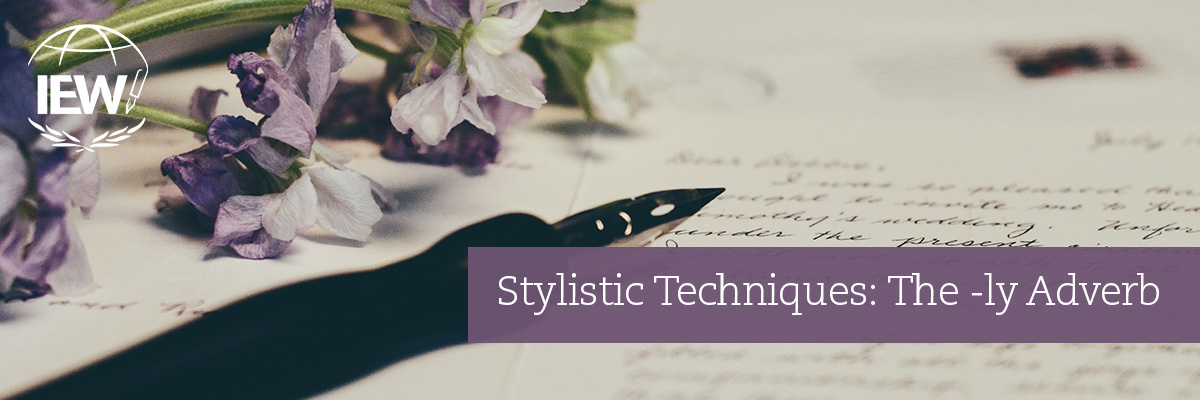
In the stylistic techniques progression, the -ly adverb is the first dress-up that students encounter. An adverb modifies either a verb, an adjective, or another adverb. These words answer the questions how, when, where, why, how often, under what conditions, or to what extent. If you own Teaching Writing: Structure and Style®, you can learn more about the stylistic techniques on Disc 2 (Video 02 in streaming). To get to the specific section where dress-ups are described, start the video at the 26:02 mark. You can find more information about the -ly adverb in the second edition of the Seminar Workbook behind the Stylistic Techniques tab, beginning on page 172.
Generally I have noticed that my students find this first dress-up to be fairly easy to insert. When I am working with my students, I enjoy introducing this technique because it is easy and fun to draw in multisensory instruction. This wasn’t my default method of teaching to begin with though. I have to give credit where credit is due. I learned from a master teacher: Andrew Pudewa. He served as my model and motivational force. Watching him present the writing lessons to his students in the TWSS Demonstration Lessons, I was able to see how he engaged with his students using his witty sense of humor and modeling with aplomb by movement and facial expression verbs and adverbs. While he made it fun, he also built his students’ schema, strengthening their comprehension. Early on in my teaching, I began to include his techniques in my own little classes and found to my delight that my students thoroughly enjoyed themselves!
This is my general approach. For my first-year students or those who are challenged learners, I like to introduce the -ly adverb by beginning with a basic sentence that I write on the whiteboard, perhaps something like this:
The king walked into the room.
Begin by identifying the verb: walked. If your students aren’t yet able to identify the verb, ask them leading questions to help them self-identify it. Who is in this sentence? (answer: the king) What is he doing? (answer: walking into the room) Aha! The king is walking! So the verb, which shows the king’s action, is walk.
Once your students discover that walk is the verb, you’re off to the races. I next ask my students, “How can a king walk into a room?” I prepare to do my kingliest walk. If I’ve thought ahead for this, I’ll even bring in a paper crown to place on my head. Young kids love that! I may start by tossing out an adverb to get them going. Even better, I like to provide a list that they can consult to share their own adverbs. Lists can be found in a number of places, including Portable Walls for Structure and Style Students, the IEW Writing Tools App, and the Student Resource Packet, just for starters.
I ask the kids, “Can a king be sad when he walks into the room?” I then begin to walk across the room with a downcast and sorrowful look on my face.
“Yes!” the kids respond. I answer back, “So you could say this: ‘The king walked into the room sadly.’” 1
Inviting your students to toss out more ways the king could walk and having you model it virtually pretty much guarantees that you’ll get participation and probably a few giggles as well. Doing a quick bit of thinking, I can come up with several -ly adverbs that are actionable: joyfully, angrily, suddenly, pensively, stonily, rapidly, and carefully are all ones that come to mind. As you begin to model the action of the adverbs, your students are learning through multiple senses: visual, auditory, kinesthetic, and while not a sense per se, I think perhaps the most important pathway is the element of humor.
One other thing to be on the watch for and warn your students about is that there are -ly imposters lurking about. These words resemble the -ly adverb in that they end with -ly. But that’s where the resemblance ends. Imposter -ly adverbs include the words lovely, holy, kingly, and ghostly, for example. These are actually adjectives, words that describe nouns. We will talk more about adjectives in a future blog post because quality adjectives are another of IEW’s stylistic techniques.
As with all the dress-ups, your student should underline the -ly adverb. The rule is that students should write and identify one -ly adverb in each paragraph in their compositions. To properly indicate it, underline it. Build the habit from the very beginning so that as new techniques are taught, the students automatically appropriately indicate them.
If you still feel uncertain about how to use a more multisensory approach to teaching stylistic techniques, have no fear! There are several places you can watch Andrew Pudewa teach students in this manner. I already mentioned the Demonstration Lessons that are on the Teaching Writing: Structure and Style discs or stream. Additionally you can watch Andrew teach in the Structure and Style for Students video lessons. If you don’t own the program, check out the free sample lessons by visiting IEW.com/free-lessons. If you teach a group of students, you will also find this video of Andrew teaching a class of Level P students to be helpful. There are a ton of places where you can learn from and be inspired by Andrew!
I hope you’ve enjoyed learning more about the -ly adverb and that it helps you as you teach your students this fun stylistic technique. It’s an enjoyable one to introduce, and most kids pick it up readily. Be sure to watch the blog for future posts about the remaining stylistic techniques!
1 I should mention a caveat, though: Word order matters. Sometimes -ly adverbs can mean different things depending upon where they are placed within the sentence. Try it with sadly, and see for yourself. “The king sadly walked into the room.” In this case, sadly could actually mean unfortunately, which is fine if that’s the meaning you’re wanting to convey, but having the sentence isolated from a paragraph makes the context unclear. If your students are working at a higher level, by all means feel free to discuss this possibility. For younger students, though, I would not delve that deeply.
|
Jennifer Mauser has always loved reading and writing and received a B.A. in English from the University of Kansas in 1991. Once she and her husband had children, they decided to homeschool, and she put all her training to use in the home. In addition to homeschooling her children, Jennifer teaches IEW classes out of her home, coaches budding writers via email, and tutors students who struggle with dyslexia. |

